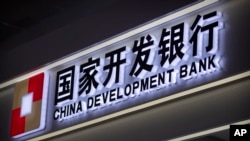China's multimillion-dollar loans to Latin American governments have come to a standstill. No new state-to-state loans have been issued over the past two years. According to experts, however, China has instead prioritized commercial loans for its companies' projects in the region.
Since 2005, China’s policy banks have been lending to countries in Latin America and the Caribbean, with the top three recipients being Brazil, Ecuador and Venezuela, often with conditions guaranteeing Beijing access to those countries’ natural resources. The region borrowed $138 billion from the China Development Bank and the Export-Import Bank (Exim) of China, distributed in 117 loans throughout the region.
The trend accelerated with the global financial crisis in 2008, which reduced the financial options for emerging markets. Countries, such as Argentina, Ecuador and Venezuela were deeply in debt with Western institutions and turned to Beijing.
China's loans to Latin America and Caribbean governments reached a peak of $34.5 billion in 2010; however, the financing came with conditions. According to Stephen Kaplan’s book, Globalizing Patient Capital: The Political Economy of Chinese Finance in the America, those conditions included requiring the borrowing countries to pay back part of their loans with oil; to purchase Chinese products such as machinery; or to give Chinese firms access to industries including telecommunications and energy.
More recently, Chinese banks are focused on financing Chinese firms that operate in the region, according to a March report by the Inter-American Dialogue and the Boston University Global Development Center.
Two decades ago, Chinese firms “had no connection to the region at all. They knew nobody. They didn't understand the operating environments [or] the investment environments,” said Margaret Myers, one of the authors of the report and director of the Asia and Latin America Program at the Inter-American Dialogue in Washington. So, the earlier strategy of conditional lending to countries “was a sort of natural means by which to help Chinese companies to establish.”
Now, Myers told VOA, the Chinese companies “have the network in place, right, so, they don't need that assistance anymore. They can strike their own deals. They can find their own opportunities, and now, they simply need the finance in place to be able to make all of that happen. So, it's a very different mechanism.”
China’s policy banks stopped offering new loans to Latin American governments in 2020. Instead, the new Chinese financial approach to the region is focused on private financing initiatives in the energy, mining, and infrastructure sectors. In 2020 and 2021, Chinese state-owned commercial banks, which include the Industrial and Commercial Bank of China, provided 12 loans in Argentina, Brazil, Colombia, Mexico and Peru. These loans are devoted to projects with a Chinese component such as a Chinese firm working in partnership with a local company.
While the earlier lending strategy enabled Chinese companies to become established in Latin American and Caribbean markets, the borrowing governments became heavily indebted. In his book, Kaplan argues that the loans were made without regard for the countries’ ability to repay, which may have encouraged them “to spend beyond their means, catalyzing future debt problems.”
'Unfavorable' Chinese loans for Ecuador
Ecuador owes China close to $5 billion, equal to 11% of its total external debt. Forty-two percent of that debt is expected to be repaid with oil by 2024.
When Ecuadorean President Guillermo Lasso visited China in February, he discussed the possibility of decoupling the debt from oil and extending the term to pay it back.
Mauricio Pozo, Ecuador’s minister of finance in 2020 and 2021, said the conditions of China's loans were very "disadvantageous" due to short loan terms and high interest rates. Ecuadorean state oil company Petroecuador reported losing money for each barrel of oil exported to China.
Petroecuador is now renegotiating with oil and gas company PetroChina to change the formula that calculates the oil price and to extend the terms of the contracts to be able to sell some of the oil on the open market.
Following Lasso’s meeting with Chinese President Xi Jinping, China’s state news agency, Xinhua, reported Xi hoped “Ecuador will continue to provide a fair and convenient business environment for Chinese enterprises to invest and operate in Ecuador.”
VOA sent several inquiries to the Chinese embassies in Ecuador, Venezuela and Washington for this story but did not receive a response.
Myers said China’s brake on lending to regional governments may have been driven in part by concerns over the ability of those governments to repay their debts.
“China has faced this problem prior to the pandemic, and during the pandemic it's become even more of a challenge,” she said. “We've seen efforts by China to restructure the terms of a few of the tranches of debt in Venezuela and also in Ecuador.”
Jorge Heine, a member of the China Global Initiative at Boston University’s Global Development Policy Center, told VOA that China "burned its fingers" with Venezuela, where the government "continues to owe $19 billion to China … and the payment is uncertain."
Venezuelan’s oil production experienced a decline from 2015 to 2021. China had granted grace periods on principal payments as Venezuela pays the interest on the debt.
Heine suggested another reason that China shifted its lending in Latin American from governments to companies was so that Beijing could “concentrate more on [domestic] development and internal investment in the coming years."
Heine added that Chinese companies no longer depend on conditional loans to secure construction contracts. Now, they are able to openly compete for contracts in countries whose governments have not borrowed from China, such as Chile, Colombia, Mexico or Peru.
"Chinese companies have realized that to participate in projects in Latin America they have to be able to win them in open tenders, open contests, because, if not, they will not have access to the projects," Heine told VOA.
Even with changes in recent lending strategies, analysts expect China to continue relationships with Latin America, selling more products to the region and gaining access to new sources of oil.





